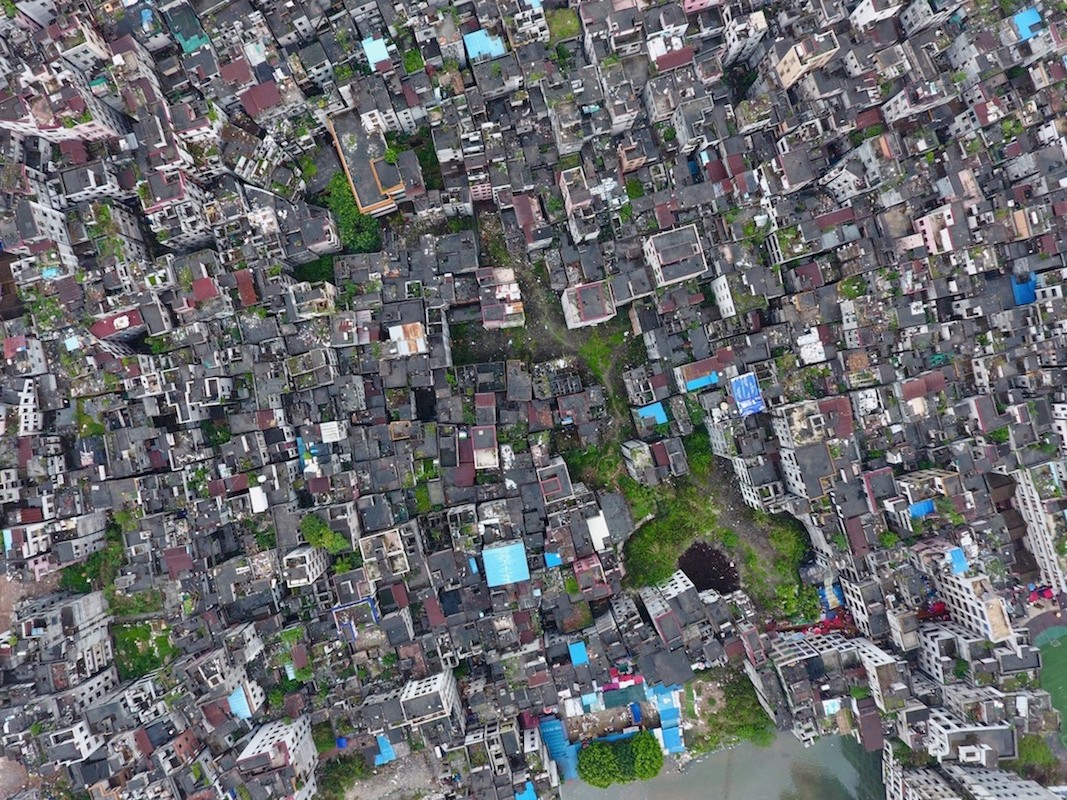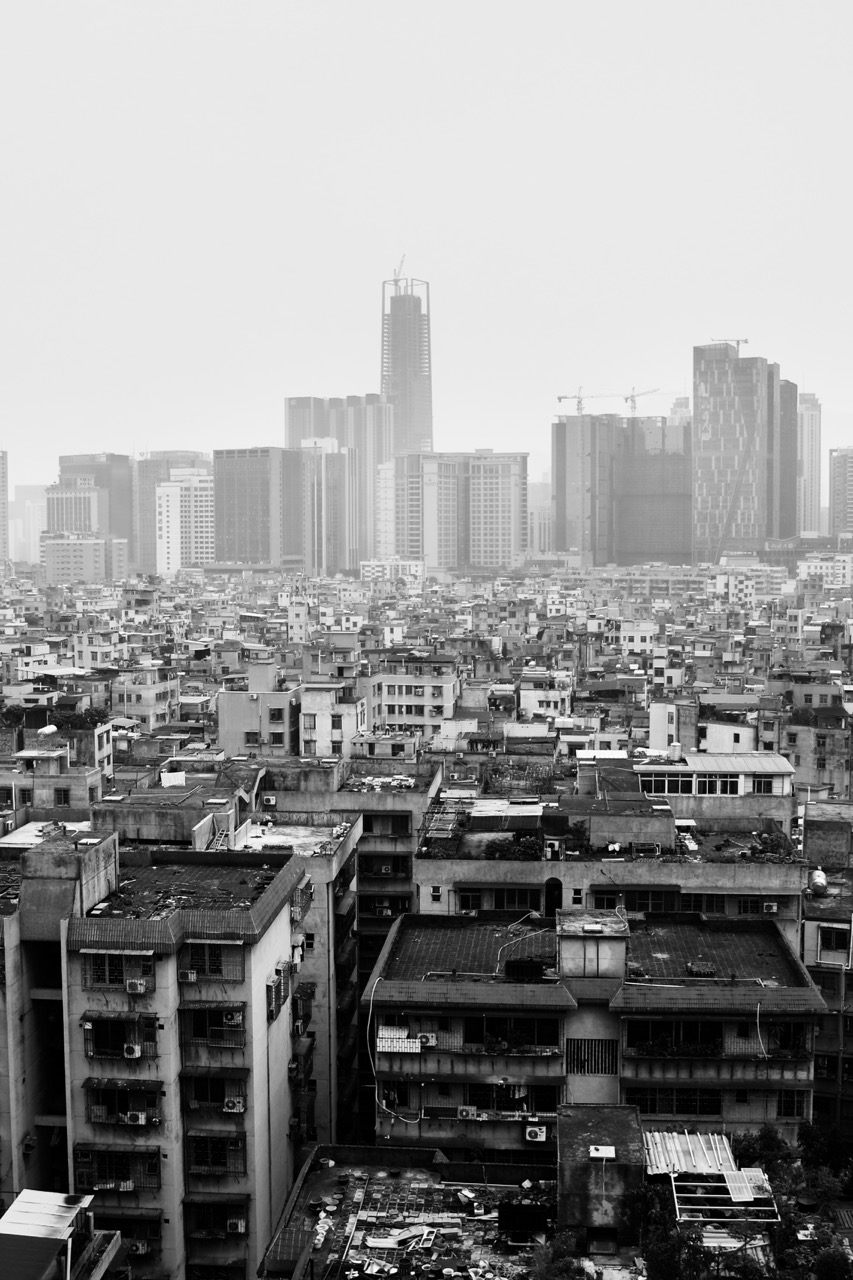Source: That’s Magazine (5/29/17)
The Fall of Guangdong’s Urban Villages, Migrants’ Last Refuge
By Bailey Hu

Imagine living in a maze of a neighborhood where apartment buildings 10 stories tall crowd so closely together that their residents dwell in perpetual shade.
Your apartment window, set with steel bars, is little more than a meter away from the building next door; if it weren’t for the frosted glass, you’d be able to see directly into the room across the alley.
Going outside and looking up, you’d glimpse the sky only in the narrow strips between buildings. But it’s better to keep your head down anyway – in the summer, air conditioners hung outside windows have a habit of dripping on unwary pedestrians.
This is life in the chengzhongcun, literally ‘villages within the city.’ In the Pearl River Delta they stand as a symbol of the rapid, sometimes uneven, development that’s taken place over the last four decades.
The neighborhood described above is a relatively nice one; in less well-kept areas, buildings are shorter and even more closely spaced together.
In a place like Baishizhou Village in Shenzhen, clumps and tangles of wires crisscross overhead in alleys, sometimes drooping low enough to touch. In Xiancun, the last remaining ‘eyesore’ of Liede, Guangzhou, heaps of trash fill the narrow cracks between apartments, a breeding ground for rats.
But despite all that, urban villages are not the depressing slums they might resemble. After meals, you can catch housewives huddling around doorways, holding babies and chatting. In nearby, narrow lanes paved with concrete, children play. Square mahjong tables are a common sight in ground-floor living rooms that open onto the street. Besides the obvious, they’re useful for drinking tea or playing cards with neighbors.
Inside what looks like the most stifling of settings is a flourishing, lively community. But it rests on an unstable foundation.
For years now, urban villages have been targeted by redevelopment policies that don’t value the neighborhoods’ inherent strengths. The unique buildings and networks of alleys in today’s urban villages are at risk of being lost forever, and their vibrant communities of migrants forced to search for new shelter in the city.
Rural Roots

The current crisis shows just how far urban villages have come in a short time. Only four decades ago, much of the area that’s now prime real estate was undeveloped, rural land. Villagers residing in small-town Bao’an County (renamed Shenzhen City in 1979) or what is now Guangzhou’s central business district couldn’t have imagined their collectively owned land might one day be so desirable that selling could guarantee a life of luxury.
The villagers’ current situation is due to a historical anomaly. In accordance with the national ‘reform and opening up’ that started in 1978, local governments bought land to prepare for urbanization. But the villagers were expensive to compensate and move. In the end, they were allowed to keep their property even as cities sprang up all around them.
Their land, still classified as ‘rural,’ fell outside city regulations on construction. Villagers were able to raise dozens of short, closely clustered apartment buildings and rent them out to migrants for a tidy profit. As affordable housing became increasingly harder to find, the ‘villages’ took on an important, even integral role in the city.
Now, well-off former villagers and their descendants have the freedom to live wherever they want. Some choose to stay in their ancestral homes, but it’s migrants who currently make up most of the urban villages’ population. They also stand to lose the most from their impending destruction.
The Case for Urban Villages
For fresh graduates, young entrepreneurs and creatives, working-class migrants and even some white-collar folks, urban villages are cheap, incredibly convenient places to live. They provide food and shopping and entertainment at price points that suit residents’ needs.
In Shenzhen’s Hubei Village, 78-year-old Chen Xiuwen says the village is one of the few places in Luohu where a single man can support his aging mother. “I’ve been here four or five years,” she says, sitting on a concrete stoop at the intersection of three alleys where she greets almost everyone who passes. “I live with my youngest son.”
Chen pickles vegetables at home and sells them from a small plastic tub every day. She’s not alone – many residents in urban villages run small businesses of their own, meaning restaurants cater to all kinds of tastes: Harbin dumplings, Sichuan malatang, Hunan ‘wooden bucket rice,’ Korean bibimbap, Hong Kong egg waffles and Taiwanese milk tea, just to name a few. Secondhand furniture shops, hair salons, fruit sellers, tiny grocery stores and similar shops proliferate at ground level.

Scholars have confirmed urban villages’ incredible vitality. Stefan Al, an architect and associate professor of urban design at UPenn, was the main editor of the book Villages in the City: A Guide to South China’s Informal Settlements (2014), which examines chengzhongcun in the PRD. According to him, mazes of alleys provide “relief from the monotony of the grid.” In contrast to dividing up residential from commercial zones, urban villages exhibit “mixed use” characteristics that promote a lively, “pedestrian friendly” street culture.
For city planners, there’s “a lot to be learned in urban villages,” Al says. It “would be a waste to just demolish them entirely,” as with the former Yumin and Dachong villages in Shenzhen, or Liede and now Xiancun in Guangzhou.
A Drone’s Eye View
Take a brief peek into Shenzhen’s Xiasha Village, with its closely clustered buildings and lively public spaces, below (VPN off).
The Downsides

While they’re undoubtedly valuable, many urban villages are also packed with buildings Al calls “substandard.” Apartments may be cramped; some lack smoke alarms, let alone elevators.
The narrow alleyways that contribute to a neighborhood’s character can also restrict emergency vehicles from entering. And despite their bustling vitality, urban villages may be seen as noisy, crowded and unsanitary by the people who live there.
They also have an unsavory history, at least according to some sources. The title of a Tencent News piece from last April, for instance, starts with: ‘Shenzhen Urban Villages’ Dark Past.’ It focuses on Xiasha Village’s reputation as a home for ernai, or ‘second wives,’ of Hong Kongers. In addition, the article brings up a notorious 2006 crackdown in which police rounded up 167 sex workers and their patrons from Xiasha and two neighboring urban villages.

But according to architect Duan Peng, whose interest in Shenzhen’s urban villages started shortly after he arrived in 2001, the view of chengzhongcun as a breeding ground for illicit activities is outdated. 2007 marked a “turning point,” he says, when surveillance cameras installed in the villages within city limits brought down crime.
Still, it’s hard to deny that urban villages were erected for profit, not comfort. Notorious ‘handshake buildings’ are so close to one another that by leaning out of their respective windows, neighboring residents can shake hands.
It’s not uncommon, according to a prior resident of Tangxia Village, Guangzhou – where some buildings are only 20 inches apart and not all windows are secured – to see someone climb into your kitchen from an adjacent patio on their way to a friend’s apartment (or while snooping around for cash).
The architectural crowding also blocks out sunlight, which in addition to creating a gloomy atmosphere forces some residents to dry their laundry on lines in the street.
Under Attack

Despite their less-than-pristine appearance, urban villages often occupy desirable locations. Chengzhongcun like Shenzhen’s Gangxia or Guangzhou’s Xiancun are even in central districts where shiny new office buildings and skyscrapers provide a sharp contrast.
To the eyes of local government and developers, urban villages may seem like eyesores, to be wiped out and replaced by more impressive, cosmopolitan structures. Even Shenzhen’s Hubei village, with its rare 500 years of history, is scheduled to be torn down to make way for a giant shopping mall.
Redevelopment plans vary between villages. Sometimes, they’re delayed due to complex negotiations over villagers’ compensation or land ownership rights. But after plans for redevelopment have been made, they’re rarely brought to a complete halt.

In Guangzhou’s Liede Village, for every square meter of property they owned, villagers were promised an equivalent amount in the new luxury apartments to be constructed in the area. Even property that violated regulations (any building higher than four stories) was compensated, at RMB1,000 a square meter. In the end, all of Liede was demolished, including an 800-year-old ancestral hall.
In Shenzhen’s Dachong Village, 168 families agreed to a government payout of more than RMB100 million in exchange for their land. Those who refused to sell had their property taken anyway when the district government exercised its right of eminent domain. The migrants were evacuated from the area, and almost all buildings razed to the ground.
In Baishizhou, Shenzhen, redevelopment is underway. At least one section of the area has been torn down, and businesses lining a main road are being pushed to leave.

Residents of some places, such as Shenzhen’s Dafen Oil Painting Village, will most likely escape this fate. Dafen is a rare success story among urban villages; not only does it support a prosperous arts industry, pumping out a large percentage of the world’s oil paintings, but over the years it’s also become a major tourist attraction.
According to Mary Ann O’Donnell, an artist and scholar whose work on urban villages began more than two decades ago, there are also other exceptions: sometimes, a village’s location simply isn’t valuable enough to attract the government’s attention.
There are signs that official opinion on urban villages may be shifting. Although they’ve been featured in previous exhibits, this year marks the first time that the Shenzhen-Hong Kong Biennale of Urbanism/Architecture, a large-scale event open to the public, will focus on urban villages as its main topic.

But even if the biennale brings more awareness, there’s no relief in sight for villages already targeted by redevelopment plans, and the migrants who make homes and run businesses there. The price hike that follows demolition and reconstruction effectively forces many of them to look elsewhere for a place to live or work.
As urban villages are torn down, cities lose some of their most vibrant neighborhoods. At the same time, the rare places that can provide working-class migrants with refuge or the chance to pursue a better future will only become harder and harder to find.
With additional reporting by Sky Thomas Gidge, Jocelyn Richards and Tristin Zhang.
Read about more urban villages in the PRD here.
[Images via NK Chu, Daniel MH Chun, Bailey Hu, Jocelyn Richards]



